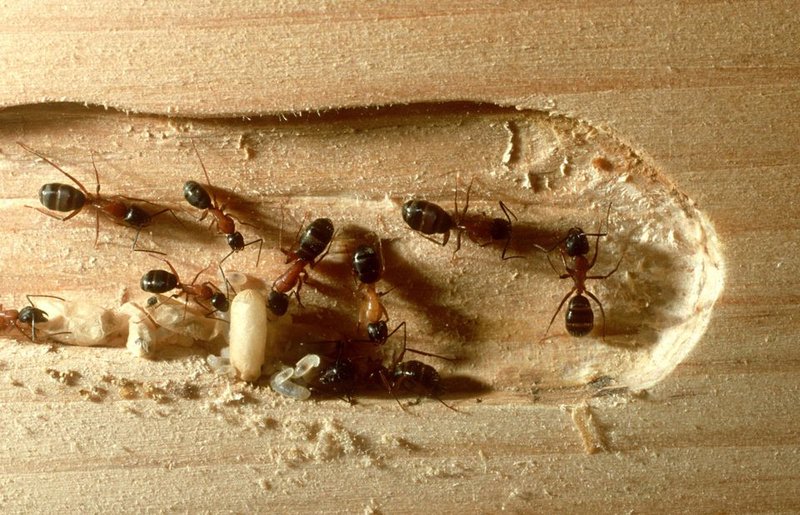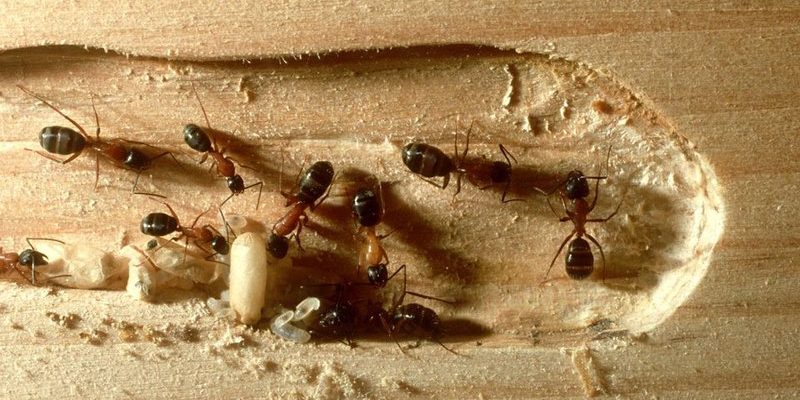
Picture a carpenter ant like a mischievous carpenter in your home. They’re not exactly out to cause chaos, but they have a way of getting into places you wouldn’t expect. While they’re not the ideal houseguest, it’s important to distinguish fact from fiction. Misconceptions about carpenter ants can lead to unnecessary panic or even ineffective pest control measures. Just like with any topic, knowing the truth can empower you to handle any situation more confidently.
Let’s explore some of the most common myths about carpenter ants and clarify what you really need to know about these wooden chewers.
Myth 1: Carpenter Ants Only Live in Wood
You might think that carpenter ants are all about that wood-life, right? After all, their name suggests they’re lumberjacks at heart. Here’s the thing, though—they don’t actually eat wood like termites do. Instead, they carve out their nests inside it. This means they’re more like skilled home builders than your typical wood-eating pests.
They often choose decaying or moist wood to create their nests, which makes them a problem if you have water damage in your home. But they can also be found in other materials like insulation, foam, and even inside walls. So, while they prefer wood, they’re not strictly limited to it. You might find them in surprising spots, like under your roof or even in your attic. Getting rid of moisture problems and doing regular inspections around your home can help keep these little builders at bay.
Myth 2: Carpenter Ants Are Just as Dangerous as Termites
If you’re worried about pests in your home, you may categorize carpenter ants alongside termites. After all, they both deal with wood, right? But here’s the twist: carpenter ants are less destructive than termites. While termites eat through wood, causing structural damage, carpenter ants only hollow it out for nesting.
Think of it like this: if termites are like hungry beavers, gnawing away at a dam, carpenter ants are more like construction workers, making modifications to suit their needs. This doesn’t mean you should ignore them, though! A large carpenter ant infestation can still lead to problems, especially if they create structural weaknesses over time. Regularly checking for nests and potential entry points can help you manage any worry.
Myth 3: Carpenter Ants Only Come Out at Night
You might have heard that carpenter ants are strictly nocturnal. While it’s true that they may be more active during the night, especially when foraging for food, they aren’t exclusively night owls.
These ants can be active any time of day, but they’re often noticed at night because that’s when they venture out of their nests. If you see them during the day, this could be a sign of a larger infestation. It’s like finding an unexpected guest in your living room while you’re making a sandwich! If you spot them scurrying around, it’s best to evaluate your space and check for nests.
Myth 4: Carpenter Ants Are Only a Problem in Summer
When the warm months roll around, you might think carpenter ants are just a summertime annoyance. But here’s the kicker: they can be a problem any time of year. While they may be more visible during warmer months, especially when they swarm to reproduce, they don’t just pack up and disappear when it gets chilly.
In fact, indoor conditions can make your home a cozy place for them to thrive during colder months. This means you could unknowingly have ants camped out in your walls or attic, waiting for warmer days to move around. Keeping an eye out for any signs of their presence year-round is key. Regular home inspections can really pay off.
Myth 5: All Carpenter Ants Are the Same
Did you know there are over 1,000 species of carpenter ants around the world? While many share common traits, they can vary significantly in color, size, and behavior. Most commonly, you’ll find the black carpenter ant, but there are also red and yellow species.
Understanding what kind you’re dealing with can be helpful for pest control. For example, certain types might prefer specific nesting sites or have different social behaviors within their colonies. Knowing your enemy is half the battle! If you’re ever unsure, consulting with a pest control expert can provide clarity.
Myth 6: DIY Solutions Always Work for Carpenter Ants
A lot of folks try do-it-yourself solutions to tackle carpenter ants. Spraying with household cleaners or pouring chemicals can seem appealing, but it’s not always effective. Here’s the thing: unless you find and eliminate the nest, you’re likely just treating the symptoms without fixing the problem.
Think about it as trying to fix a leaky faucet by just mopping up the water. Without addressing the root cause, the leak will eventually return. Sometimes, enlisting the help of a professional may be the best route. They can provide targeted treatments that are both safe and effective, ensuring you don’t have any surprise guests lurking in your walls.
Myth 7: Carpenter Ants Aren’t a Big Deal
Finally, some people brush off carpenter ants as no big deal. Sure, they might not seem as menacing as other pests, but ignoring them can lead to serious issues. As mentioned earlier, a small infestation can grow, potentially leading to structural damage in your home.
Being proactive is key. If you notice signs of carpenter ants—like trails or wood shavings—address it sooner rather than later. You wouldn’t put off a leaky roof, right? Treating the problem early on can save you time, money, and headaches in the long run.
Understanding carpenter ants is crucial for keeping them under control. By busting these common myths, you’ll be better prepared to handle any ant issues that come your way. Remember, these little creatures are more than just pests; they’re part of the ecosystem. But when they start invading your space, a little knowledge can go a long way.
If you notice them in your home, don’t panic. Just take a deep breath, assess the situation, and, if necessary, reach out to a pest control professional. You’ve got this!

